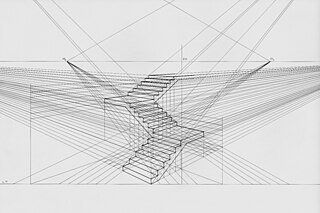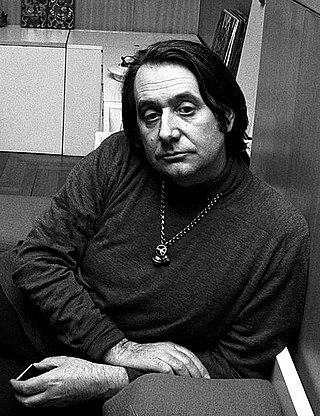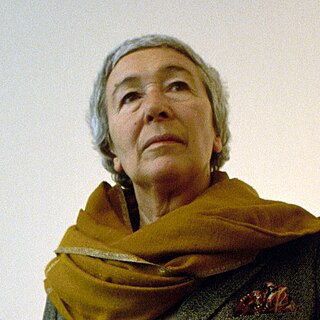Related Research Articles

A 3D projection is a design technique used to display a three-dimensional (3D) object on a two-dimensional (2D) surface. These projections rely on visual perspective and aspect analysis to project a complex object for viewing capability on a simpler plane.

Linear or point-projection perspective is one of two types of graphical projection perspective in the graphic arts; the other is parallel projection. Linear perspective is an approximate representation, generally on a flat surface, of an image as it is seen by the eye. Perspective drawing is useful for representing a three-dimensional scene in a two-dimensional medium, like paper.

Ettore Sottsass was a 20th century Italian architect, noted for also designing furniture, jewellery, glass, lighting, home and office wares, as well as numerous buildings and interiors — often defined by bold colours.

Axonometric projection is a type of orthographic projection used for creating a pictorial drawing of an object, where the object is rotated around one or more of its axes to reveal multiple sides.

Lina Bo Bardi, born Achillina Bo, was an Italian-born Brazilian modernist architect. A prolific architect and designer, she devoted her working life, most of it spent in Brazil, to promoting the social and cultural potential of architecture and design. While she studied under radical Italian architects, she quickly became intrigued with Brazilian vernacular design and how it could influence a modern Brazilian architecture. During her lifetime it was difficult to be accepted among the local Brazilian architects, because she was both a "foreigner" and a woman.
Charles Willard Moore was an American architect, educator, writer, Fellow of the American Institute of Architects, and winner of the AIA Gold Medal in 1991. He is often labeled as the father of postmodernism. His work as an educator was important to a generation of American architects who read his books or studied with him at one of the several universities where he taught.

Antonio Sant'Elia was an Italian architect and a key member of the Futurist movement in architecture. He left behind almost no completed works of architecture and is primarily remembered for his bold sketches and influence on modern architecture.

Baldassare Tommaso Peruzzi was an Italian architect and painter, born in a small town near Siena and died in Rome. He worked for many years with Bramante, Raphael, and later Sangallo during the erection of the new St. Peter's. He returned to his native Siena after the Sack of Rome (1527) where he was employed as architect to the Republic. For the Sienese he built new fortifications for the city and designed a remarkable dam on the Bruna River near Giuncarico. He seems to have moved back to Rome permanently by 1535. He died there the following year and was buried in the Rotunda of the Pantheon, near Raphael.

In three-dimensional geometry, a parallel projection is a projection of an object in three-dimensional space onto a fixed plane, known as the projection plane or image plane, where the rays, known as lines of sight or projection lines, are parallel to each other. It is a basic tool in descriptive geometry. The projection is called orthographic if the rays are perpendicular (orthogonal) to the image plane, and oblique or skew if they are not.

Gaetano Pesce is an Italian architect and a design pioneer of the 20th century. Pesce was born in La Spezia in 1939, and he grew up in Padua and Florence. During his 50-year career, Pesce has worked as an architect, urban planner, and industrial designer. His outlook is considered broad and humanistic, and his work is characterized by an inventive use of color and materials, asserting connections between the individual and society, through art, architecture, and design to reappraise mid-twentieth-century modern life.

Technical Illustration is illustration meant to visually communicate information of a technical nature. Technical illustrations can be components of technical drawings or diagrams. Technical illustrations in general aim "to generate expressive images that effectively convey certain information via the visual channel to the human observer".

Kenneth Brian Frampton is a British architect, critic and historian. He is the Ware Professor of Architecture at the Graduate School of Architecture, Planning, and Preservation at Columbia University, New York. He has been a permanent resident of the United States since the mid-1980s. Frampton is regarded as one of the world's leading historians of modernist architecture.

Raimund Johann Abraham was an Austrian architect.

Gaetana "Gae" Aulenti was an Italian architect and designer who was active in furniture design, graphic design, stage design, lighting design, exhibition and interior design. She was known for her contributions to the design of important museums such as the Musée d'Orsay in Paris, the Contemporary Art Gallery at the Centre Pompidou in Paris, the restoration of Palazzo Grassi in Venice, and the Asian Art Museum of San Francisco. Aulenti was one of only a few women architects and designers who gained notoriety in their own right during the post-war period in Italy, where Italian designers sought to make meaningful connections to production principles, and influenced culture far beyond Italy. This avant-garde design movement blossomed into an entirely new type of architecture and design, one full of imaginary utopias leaving standardization to the past.

An architectural drawing or architect's drawing is a technical drawing of a building that falls within the definition of architecture. Architectural drawings are used by architects and others for a number of purposes: to develop a design idea into a coherent proposal, to communicate ideas and concepts, to convince clients of the merits of a design, to assist a building contractor to construct it based on design intent, as a record of the design and planned development, or to make a record of a building that already exists.
George Joseph Ranalli is an American modernist architect, scholar, curator, and fellow of the American Institute of Architects. He is based in New York City.

Pier Giacomo Castiglioni was an Italian architect and designer.

Lauretta Vinciarelli was an artist, architect, and professor of architecture at the collegiate level.

Andrea Branzi is a Florence-born Italian architect and designer. He currently lives and works in Milan and was a professor and chairman of the School of Interior Design at the Polytechnic University of Milan until 2009.

Livio Castiglioni was an Italian architect and designer. He made a significant contribution to twentieth-century Italian lighting design and was an early proponent of the practice of industrial design in Italy.
References
- ↑ "Biography '43 - 60s". Massimoscolari.it. Retrieved 2022-10-31.
- 1 2 3 "Biography". Massimoscolari.it. Retrieved 2022-10-31.
- ↑ Hal Foster (September 1980). "Reviews: New York - Massimo Scolari, The Institute for Architecture and Urban Studies". Artforum . pp. 63–64. Retrieved 2022-10-31.
- ↑ "Massimo Scolari - Italian, born 1943". The Museum of Modern Art. Retrieved 2022-10-31.
- ↑ "Scolari Massimo Suchausgabe" [Scolari Massimo search results](PDF) (in German). German Architecture Museum. 2020. Retrieved 2022-10-31.
- ↑ "Massimo Scolari, Architecte". Artist/personality (in French). Centre Pompidou. Retrieved 2022-10-31.
- ↑ "Postmodern Visions: Drawings, Paintings, and Models by Contemporary Architects". Publishers Weekly . Retrieved 2022-10-31.
- ↑ "Hypnos". Publishers Weekly. Retrieved 2022-10-31.
- ↑ Furuto, Alison (January 24, 2012). "Massimo Scolari: The Representation of Architecture, 1967–2012 Exhibition". ArchDaily.
- ↑ "Oblique Drawing: A History of Anti-Perspective". Publishers Weekly. Retrieved 2022-10-31.
- ↑ Eduardo Prieto (June 30, 2013). "Pensar y representar - Axonometrics, Symbolic Forms". Arquitectura Viva. Retrieved 2022-10-31.
- ↑ "Massimo Scolari wins the Arnold W. Brunner Memorial Prize". Gizmo. 2 April 2014. Retrieved 2022-10-31.